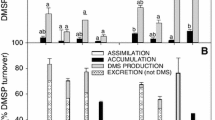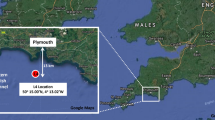Abstract
In the Sargasso Sea, maximum dimethylsulfide (DMS) accumulation occurs in summer, concomitant with the minimum of chlorophyll and 2 months later than its precursor, dimethylsulfoniopropionate (DMSP). This phenomenon is often referred to as the DMS “summer paradox”. It has been previously suggested that the main agent triggering this pattern is increasing irradiance leading to light stress-induced DMS release from phytoplankton cells. We have developed a new model describing DMS(P) dynamics in the water column and used it to investigate how and to what extent processes other than light induced DMS exudation from phytoplankton, may contribute to the DMS summer paradox. To do this, we have conceptually divided the DMS “summer paradox” into two components: (1) the temporal decoupling between chlorophyll and DMSP and (2) the temporal decoupling between DMSP and DMS. Our results suggest that it is possible to explain the above cited patterns by means of two different dynamics, respectively: (1) a succession of phytoplankton types in the surface water and (2) the bacterially mediated DMSP(d) to DMS conversion, seasonally varying as a function of nutrient limitation. This work differs from previous modelling studies in that the presented model suggests that phytoplankton light-stress induced processes may only partially explain the summer paradox, not being able to explain the decoupling between DMSP and DMS, which is possibly the more challenging aspect of this phenomenon. Our study, therefore, provides an “alternative” explanation to the summer paradox further underlining the major role that bacteria potentially play in DMS production and fate.












Similar content being viewed by others
References
Archer SD, Gilbert FJ, Allen JI, Blackford JC, Nightingale PD (2004) Modelling of the seasonal patterns of dimethylsulphide production and fate during 1989 at a site in the North Sea. Can J Fish Aquat Sci 61:765–787
Archer SD, Cummings DG, Llewellyn CA, Fishwick JR (2009) Phytoplankton taxa, irradiance and nutrient availability determine the seasonal cycle of DMSP in temperate shelf seas. Mar Ecol Prog Ser 394:111–124
Bailey KE, Toole DA, Blomquist B, Najjar RG, Huebert B, Kieber DJ, Kiene RP, Matrai P, Westby GR, del Valle DA (2008) Estimation of dimethylsulfide production in Sargasso Sea Eddies. Deep Sea Res II 55:1491–1504
Baretta JW, Ebenhoh W, Ruardij P (1995) The European regional Seas Ecosystem Model, a complex marine ecosystem model. Neth J Sea Res 33:233–246
Blackford JC, Allen JI, Gilbert FJ (2004) Ecosystem dynamics at six contrasting sites: a generic modelling study. J Mar Syst 52:191–215
Bopp L, Aumont O, Belviso S, Blain S (2008) Modelling the effect of iron fertilization on dimethylsulphide emission in the Southern Ocean. Deep Sea Res II 55:901–912
Burchard H, Bolding K, Villareal M (1999) GOTM: a general ocean turbulence model. Theory, applications and test cases. Technical Report EUR 18745 EN, European Commission
Charlson RJ, Lovelock JE, Andreae MO, Warren SG (1987) Oceanic phytoplankton, atmospheric sulphur, cloud albedo and climate. Nature 326:655–661
Dacey JWH, Howse FA, Michaels AF, Wakeham SG (1998) Temporal variability of dimethylsulfide and dimethylsulfoniopropionate in the Sargasso Sea. Deep Sea Res I 45:2085–2104
Geider RJ, MacIntyre H, Kana TM (1997) Dynamic model of phytoplankton growth and acclimation: responses of the balanced growth rate and the chlorophyll a: carbon ratio to light, nutrient-limitation and temperature. Mar Ecol Prog Ser 148:187–200
Keller MD, Bellows WK, Guillard RRL (1989) Dimethyl sulfide production in marine-phytoplankton. Am Chem Soc Symp Ser 393:167–182
Kiene RP, Linn LJ, Bruton JA (2000) New and important roles for DMSP in marine microbial communities. J Sea Res 43:209–224
Le Clainche Y, Vézina A, Levasseur M, Cropp RA et al (2010) A first appraisal of prognostic ocean DMS models and prospects for their use in climate models. Global Biogeochem Cycles 24 GB3021. doi:10.1029/2009GB003721
Lefévre M, Vézina A, Levasseur M, Dacey JWH (2002) A model of dimethylsulfide dynamics for the subtropical North Atlantic. Deep Sea Res I 49:2221–2239
Liss PS, Hatton AD, Malin G, Nightingale PD, Turner SM (1997) Marine sulphur emission. Phil Trans R Soc B Biol Sci 352:159–168
Malmstrom RR, Kiene RP, Kirchman DL (2004) Identification and enumeration of bacteria assimilating dimethylsulfoniopropionate (DMSP) in the North Atlantic and Gulf of Mexico. Limnol Oceanogr 49(2):597–606
Polimene L, Allen JI, Zavatarelli M (2006) Model of interactions between dissolved organic carbon and bacteria in marine systems. Aquat Microbial Ecol 43:127–138
Simó R, Pedrós-Alió C (1999) Role of vertical mixing in controlling the oceanic production of dimethyl sulphide. Nature 402:396–399
Steinberg KS, Carlson CA, Bates NR, Johonson RJ, Michaels AF, Knap AH (2001) Overview of the US JGOFS Bermuda Atlantic Time-series Study (BATS): a decade-scale look at ocean biology and biogeochemistry. Deep Sea Res II 48:1405–1447
Stoderegger K, Herndl GJ (1998) Production and release of bacterial capsular material and its subsequent utilization by marine bacterioplankton. Limnol Oceanogr 43(5):877–884
Sunda W, Kieber DJ, Kiene RP, Huntsman S (2002) An antioxidant function for DMSP and DMS in marine algae. Nature 418:317–320
Sunda W, Hardison R, Kiene RP, Bucciarelli E, Harada H (2007) The effect of nitrogen limitation on cellular DMSP and DMS release in marine phytoplankton: climate feedback implication. Aquat Sci 69:341–351
Toole DA, Siegel DA (2004) Light-driven cycling of dimethyl-sulfide (DMS) in the Sargasso Sea: closing the loop. Geophys Res Lett 31:L09308. doi:10.1029/2004GL019581
Toole DA, Siegel DA, Doney SC (2008) A light-driven, one-dimensional dimethylsulfide biogeochemical cycling model for the Sargasso Sea. J. Geophys. Res 113:G02009. doi:10.1029/2007JG000426
Vallina SM, Simó R, Anderson TR, Gabric A, Cropp R, Pacheco JM (2008) A dynamic model of oceanic sulphur (DMSO) applied to the Sargasso Sea: simulating the dimethylsulfide (DMS) summer paradox. J Geophys Res 113:G01009. doi:10.1029/2007JG000415
Vila-Costa M, del Valle DA, Gonzales JM, Slezak D, Kiene RP, Sanchez O, Simó R (2006) Phylogenetic identification and metabolism of marine dimethylsulfide-consuming bacteria. Environ Microbiol 8(12):2189–2200
Vila-Costa M, Kiene RP, Simó R (2008) Seasonal variability of the dynamics of dimethylated sulfur compounds in a coastal northwest Mediterranean site. Limnol Oceanogr 53(1):198–211
Vogt M, Vallina SM, Buitenhuis ET, Bopp L, Le Quere C (2010) Simulating dimethylsulphide seasonality with the dynamic green ocean Model PlankTOM5. J Geophys Res 115:C06021. doi:10.1029/2009JC005529
Acknowledgments
This work was supported by the Natural Environment Research Council of the United Kingdom and forms part of the Surface Ocean Lower Atmosphere Studies (SOLAS) thematic projects: NE/E011314/1 (DUST-UP) and NE/C51715X/1.
Author information
Authors and Affiliations
Corresponding author
Rights and permissions
About this article
Cite this article
Polimene, L., Archer, S.D., Butenschön, M. et al. A mechanistic explanation of the Sargasso Sea DMS “summer paradox”. Biogeochemistry 110, 243–255 (2012). https://doi.org/10.1007/s10533-011-9674-z
Received:
Accepted:
Published:
Issue Date:
DOI: https://doi.org/10.1007/s10533-011-9674-z




